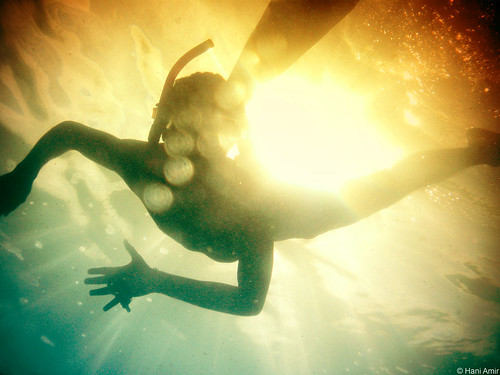How to Avoid Common Problems in Underwater Photography
These days anyone who can swim can take photos underwater. In most cases you don’t even need to buy a whole new camera setup- it’s possible to fit a clear plastic underwater housing to many popular digital compacts. A housing will protect your everyday camera from the water while still letting you access the functions and camera settings.
However, there are a few underwater problems that surface photographers never have to face. Here are a few tips to help you avoid the common ones when you first try taking your camera underwater:
No matter how good your housing is, there are some things you can’t do in the water. Changing batteries is one. Putting in a fresh memory card is another. Make sure the camera is charged up and has plenty of free memory before taking the plunge. It’s also a good idea to take a few shots on the surface before getting wet. Put the housing on and make sure everything is working as it should. Then you can get into the water with confidence.
Beware of backscatter. This might be the issue that ruins more underwater photographs than anything else. Even water that looks fairly clear to the human eye will hold countless tiny suspended particles. The light from a flash can reflect off these and go back to hit the camera lens. The result is an image peppered with tiny white spots.
The best way to get rid of backscatter is to use an external flash or strobe. For best results it should be held away from the camera and aimed on the edge of the subject rather than directly on it. Light will still reflect off those suspended particles but it’ll bounce harmlessly away from your lens.
If you haven’t got an external flash, try turning your internal flash off and shooting in daylight. In the editing stage it’s usually easier to fix an image that’s a little too dark and colorless than it is to try and filter out backscatter spots.
The third way to beat backscatter is to get closer to the subject. The less water there is between it and the lens, the less backscatter there will be. Most underwater photographers get their best shots in macro mode- at least when they first start out.
Colors have a tendency to wash out underwater. Shooting close-ups is one way to keep colors bright and using an external flash is another. If you haven’t got one, trying getting a friend to help you out with a strong dive flashlight. Again, it’s better to aim the beam just a little to one side of the subject.
An external lighting source will help bring out vivid colours but it can also cause new difficulties. When a bright light reflects off a shiny fish or even a patch of pale sand, it can cause a hotspot or white patch in the final image. If you’re shooting close to the surface, strong lighting can also appear unnatural if it doesn’t have the same color balance as the natural sunshine. Where possible, shoot without a flash to avoid these problems. Where the water is too dark or too murky, an external flash is your friend if you choose the angles carefully.
As with surface photography, experimentation is the key to working out what works and does not work underwater. Try macro and wide shots, play with lighting angles, and see what comes out. Taking a great photo underwater can be tricky but you’ll never be short of an interesting subject.




